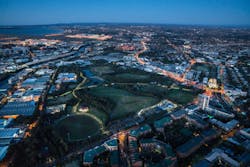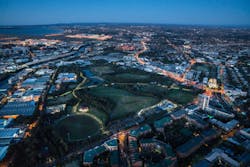Sydney Park: A Flagship for Stormwater Success
Costing AUD$11.2 million, the Sydney Park project embodies Australia’s advanced stormwater management success. Helping the city to meet ambitious targets, as well as reusing water, what can the site share with other countries facing stormwater challenges?
By Paul Grad
Sydney Park, the site of the Sydney Park Stormwater Reuse Project, is being redesigned to harvest massive amounts of stormwater. Located in the suburb of St Peters, sitting along the borders of the suburbs of Alexandria, Newtown and Erskineville, the park covers an area of 108 acres (41.6 hectares) and comprises large open recreation spaces, a children’s playground, wetlands, a sports oval, and a children’s bicycle track.
The AUD$11.2 million upgrade, co-founded by the City of Sydney and the federal government, will see about 850 million litres of stormwater a year captured, cleaned for release downstream or for potential reuse. The project will help the city achieve its 2030 target for reducing sediments and nutrients from stormwater runoff and for meeting 10% of water demand through local water capture and reuse.
In Australia the stormwater system is separate from the sewer system and unlike sewage, stormwater is usually not treated before being discharged to waterways or to the sea.
Poorly managed stormwater can cause erosion, and the transportation of nutrients, pollutants, litter and sediments to waterways. The massive volumes of pollutants associated with stormwater runoff are deadly for streams and waterways, and lead to a condition called “urban stream syndrome”.
Well-managed stormwater, on the other hand, can replace imported water for uses where high quality water is not required, such as irrigation or garden watering. Furthermore, reusing stormwater can save potable water and reduce downstream environmental impacts.
The Sydney Park Stormwater Reuse project includes: diverting stormwater through underwater pipes, filtering water through a pollutant trap and a series of bio-retention beds, revitalizing the park’s wetland system to increase storage and improve water filtering, and adding several amenities and facilities for recreation. These stormwater retention ponds built in the eastern section of the site have been transformed into wetland habitats, partly recreating the original character of the site, which has attracted a wide variety of bird and animal life.
In total, Sydney Park has four wetland areas which constitute an important part of the park’s ecosystem as well as playing a role in flood mitigation. A sustainable water supply protects the wetlands from poor plant establishment; blue-green algae blooms; and rapid growth of submerged aquatic plants such as azolla, which block sunlight.
Facing twin problems
Good urban stormwater management is crucial, particularly for countries such as Australia, where climate change is expected to create the twin problems of increasingly frequent droughts and heavy storms. The best tool to deal with those challenges could be low-impact development (LID) technologies which mimic the natural landscape’s handling of heavy precipitation prior to the creation of the built environment. LID is also known as integrated water management (IWM), or water sensitive urban design (WSUD).
This includes stormwater harvesting to reduce the possibility of flooding, infiltration to restore the natural recharge of groundwater, biofiltration or bioretention to store and treat runoff, green roofs that are capable of both absorbing then evapotranspiring rainfall and permeable paving.
The stormwater reuse project is a good illustration of advanced use of LID methods. The park’s water is treated using a pollution trap which removes litter, coarse sediment and organic matter from stormwater through a physical screen; a bioretention system that collects water in shallow depressions and filters it through plant roots and soil; and more filtration and ultraviolet cleansing processes as water is drawn for reuse. The work is being done in phases. The initial phase will harvest and treat 535 million litres of stormwater per year through 2400 m2 of bioretention located next to wetland two.
As part of the next phase, a total volume of 845 million litres per year will be harvested through an additional 1600 m2 of bioretention located next to wetland four.
The City of Sydney is the client and project manager. Other team leaders in the project include: Turf Design and Environmental Partnership (lead design consultant and landscape architect); and Alluvium (civil, hydraulic and sustainable water management).
Going underground
Another major stormwater project in Sydney is the green square Stormwater Drain Project. Built by Sydney Water and the City of Sydney, it will involve a 2km underground stormwater drain from Zetland to the existing stormwater system at Alexandra Canal.
The Green Square area sits on a floodplain known as the Waterloo Swamp. The new drain will reduce flooding in and around the Green Square Town Centre. Construction of the drain is excepted to be completed by mid 2018.
The City of Sydney and Sydney Water have formed an alliance with UGL Engineering, Seymour Whyte Constructions, Parsons Brinckerhoff Australia, and RPS Manidis Roberts to deliver the project.
Visiting Professor Stanley B Grant, of the University of California, Irvine (UCI) and his team were awarded a grant from the US’ National Science Foundation to study the technologies and policies put in place by Australia during the Millennium Drought and their potential adoption in the southwestern US to mitigate future water supply policies.
The Millennium Drought was an exceptionally dry period from late 1996 to mid-2010 which affected much of southern Australia.
“Generally I can say that Australia is way ahead of the curve, which is why we won a $5 million grant to figure out how cities in Australia responded to the Millennium Drought, and see if there are lessons for the US and beyond,” he says.
“The short answer is: absolutely, but the challenge (in all countries, including Australia) is to stay vigilant, even when the rains return. I think what impressed me the most about Australia’s experience with the Millennium Drought was the degree to which government, industry, academia, and everyday citizens came together to conserve water. I don’t think we’ve seen that in the US, and not in too many other places in the world.
“The best part is that emerging from one of the longest droughts in Australia’s history, Melbourne has been voted year after year as the most liveable city in the world. We could definitely use some of their magic,” he says.
Meanwhile, Queensland engineer Grant Witheridge, principal of Catchments & Creeks of Brisbane, believes in Australia the science behind stormwater management is advanced, compared with the rest of the world. He says the Sydney Park project, in particular, embodies very good work and represents advanced stormwater management.
Looking at stormwater management in Australia’s capital cities, he believes Sydney, Melbourne and Brisbane are the Australian cities with the best stormwater management. He says Melbourne has advanced stormwater treatment, but due to poor maintenance its stormwater management system has deteriorated.
He adds that councils can usually not afford to support maintenance work. It would be necessary to decide which devices need to be under the control of councils or body corporate.
Considering technologies on an equal footing
Capitalising on the success to date, stormwater Australia, the umbrella organisation for all Australian stakeholders in the stormwater industry, has launched the SQIDEP (Stormwater Quality Improvement Device Evaluation Protocol) database. SQIDEP will allow evaluating the performance claims made for stormwater quality improvement devices.
The protocol will allow current and emerging technologies to be considered on an equal footing. It has been designed to provide a high level of confidence in selecting proprietary devices for real world applications and it will also help direct research, development and innovation.
Based in Australia, Paul Grad is a freelance contributor for WWi magazine.
More Water & WasteWater International Archives Issue Articles


